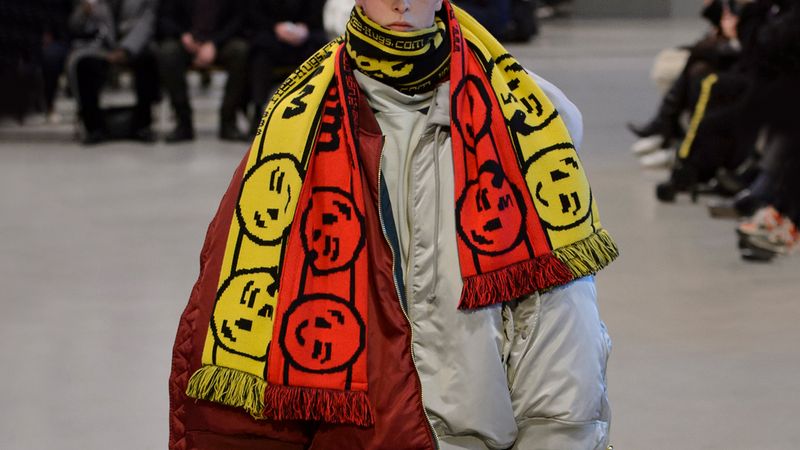THE JOURNAL

Vetements runway, Paris, January 2017. Photograph by IMAXTREE
Why the fan favourite has made its way into our wardrobes this season.
You can split the MR PORTER team into two distinct groups: those who follow football and those who don’t. The former includes Messrs Tom M Ford and Dan Rookwood, diehard supporters of Manchester United and Liverpool respectively. The latter includes the esteemed editor of this platform, Mr Adam Welch, a man whose personal Premier League consists of Missoni, Prada and visvim.
But who do you suppose has been wearing a football scarf to work for the past few weeks? The logical answer is Mr Ford or Mr Rookwood. If you’ve been keeping abreast of the latest developments in men’s style, however, you’d have every reason to plump for Mr Welch. And you’d be right. In a development that’s sure to confuse your parents, the garish, acrylic-blend football scarves that were once the preserve of terrace hooligans are now the toast of the style set.
How did this happen? What does it mean? And should you consider getting on board with it? For the answers to all of those questions and more, read on.
Who do we have to thank for this trend?
Like most of the left-field trends to have emerged in the past couple of years, Vetements had a hand in this one, including a fake Russian football scarf in its Fall 2015 collection. Streetwear brands Gosha Rubchinskiy, Supreme, Palace and Stüssy were other early adopters. This season, brands such as Givenchy are following suit, while in a related development, The Elder Statesman has produced a range of cashmere scarves decorated with the names and logos of NBA teams.
Why are they so popular?
They’re tribal emblems that also happen to be colourful accessories. They denote affiliation to a subculture while simultaneously adding a pop to your outfit. What’s not to like?
But aren’t they a bit, er, naff?
Extremely. And that’s part of their appeal. As we touched upon in the previous edition of “Let’s Talk About...”, which tackled the subject of how knock-off became cool, the dominant narrative in the fashion world over the past couple of years has been the tongue-in-cheek appropriation of things that aren’t typically considered cool or desirable. Fake T-shirts, corporate logos, tacky football scarves… It’s all part of the same trend.
Speaking of appropriation, let’s assume I know nothing about football. If I wear one of these scarves, could I be accused of appropriating working-class culture?
Hardly. The days when football was considered the sport of the working class are long gone, and it’s frankly patronising to both football fans and the working class to suggest otherwise. Still, you can never be too careful about these things. Football is broadly equivalent to a religion among its most ardent supporters, and the scarf is one of its sacred objects. This was highlighted by the recent backlash against half-and-half “match-day” scarves, which bear the colours and names of two rival teams on a single scarf, an unforgivable blasphemy in the eyes of hardcore supporters, who see the scarf as a form of tribal affiliation.
That seems like a bit of an overreaction.
Your words, not ours. At any rate, this isn’t a problem you should have to worry about with the football-style scarves designed by Vetements, Stella McCartney et al, which don’t bear the colours and emblems of real teams. It’s hard to insult something that doesn’t exist.
OK. As for wearing them, any tips?
This is a great way of introducing a little colour into your outfit, so try it over a black or navy overcoat or Puffa jacket. Look, it’s a scarf – you can figure it out. Just make sure you switch it for something neutral if you ever happen to be in Belgrade on derby day. Like we said, you can never be too careful.
TRY THESE
Keep up to date with The Daily by signing up for our weekly email roundup. Click here to update your preferences